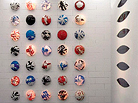Brygida Wróbel-Kulik — Illebiland — graphics, drawings, paintings…

‘(…) Brygida Wróbel-Kulik freely moves through historical and psychological time, joining social exegeses together with her own individual interpretations into one intertextual text. She is perfectly aware that cartography (like each other ‘graphy’) is, in fact, a ‘graphy’ of mental genealogy, and that being the principle of reality, it is not the reality itself. The lesson drawn from works by Ludwig Wittgenstein, René Magritte, Jasper Johns and Jorge L. Borges, not even mentioning the key works by Jean Baudrillard, is binding and obvious for today’s culture. Moreover, it’s not the reason for announcing the decline of the idea of representation. Works of this author show perfectly that we can draw knowledge and creative inspiration from the lack of congruence between notions and things, and from the rift between the idea and the object, finding real values in it. The announced crisis of representation can become a contribution and inspiration for some new (self)critical considerations and for the constructing of new aesthetics.
A contemporary artist who constructs his oeuvre around the idea of territory, has firstly to make the summary of spaces (both mental and material), then de-territorialise and de-construct it in order to get the final effect of re-territorialisation. Therefore the new territory is a result of the play of mirror reflections and transformations. It shows the tectonics of the used structures, and simultaneously it presents the potential of new reading. Hence all Brygida Wróbel-Kulik’s ‘maps’ are the transformations and reflections of mental and emotional states, as well as the paraphrases and metaphors of actual places. They become something specific, since they evoke what was and generate what can be. Every motive and figure taken from the panorama of visual memory is a topos which gets mobility and becomes atopic in the artist’s hands. No doubts this kind of lacking positioning results from the fact that the centre had been delocalised, that today the original and mythical Eden is a kind of mental lack of positioning. And since the identity is, as a matter of fact, a process and a transformation, each centre is subjected to fluctuation and is always situated only here and now, i.e. exactly in the place and moment when a work (place, identity) is being made, created and interpreted. (…)’
Roman Lewandowski
Fragment of the text entitled ‘Beyond the matrix of the (in)visible world there’s only silence’.

catalogue ‘Brygida Wróbel-Kulik — Illebiland’ “The issues relating to the interpretation and portrayal of space, along with its relationship to the visual arts, date back to prehistoric times. After...

The artist was born in 1952 in Poland. In the years 1973-1978 she studied at the Academy of Fine Arts in Cracow under the direction of Prof. Mieczysław Wejman. In the years 1984-1985 studied at the Academy of Fine Arts in Düsseldorf under the direction of Prof. Günter Uecker. In 1985 she was awarded with the City of Aachen Prize for her achievements in the area of plastic arts. She collaborates with the one and only Museum of Women’s Art in Europe. Her forms of artistic expression include printmaking, painting, artistic book and installations. In the middle of the seventies she started to create her ‘Small Gardens’, the interventions in the world of nature, which are close to the experiences of land-art. In the years 1986–1988 she created the ‘Library for Miriam’, a kind of artistic diary which came into being in result of repainting patterns of wall papers and superposing various texts on each other. Brygida Wróbel-Kulik is an artist, who has consistently subordinated all her plastic creation to the idea of topography of a place, idea of creating her own imaginary space, a specific place, chosen and elevated to an almost sanctified level with personal mythology and experiences. Her ‘layer pictures’, being a kind of the maps of still uncharted and undiscovered places and ‘blank pages’, reflect the conceptions of psychological topography, which are close to theories of Gaston Bachelard.
The exhibition prepared in collaboration with the region of North Rhine-Westphalia and the city of Düsseldorf.




